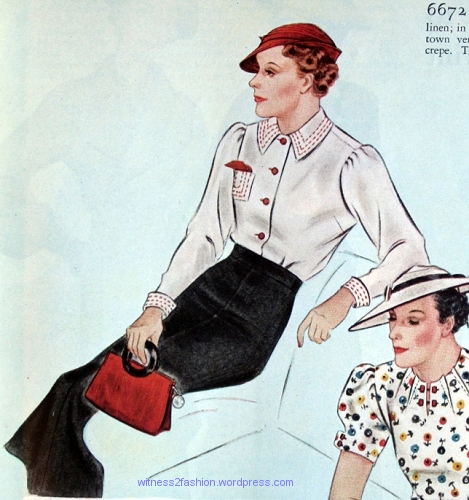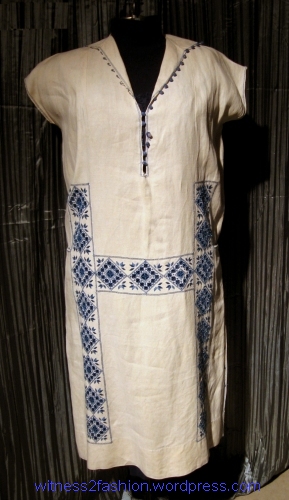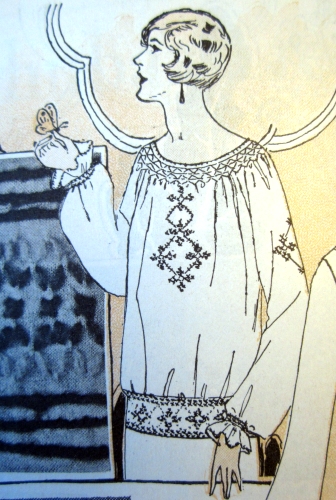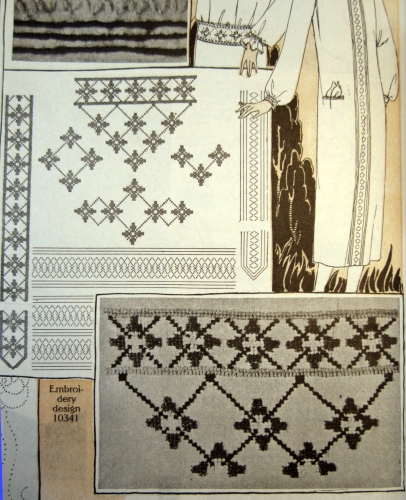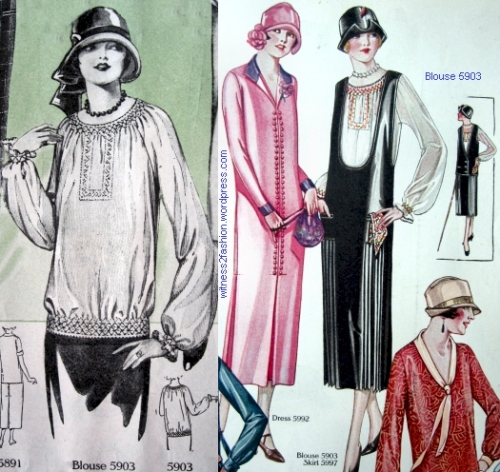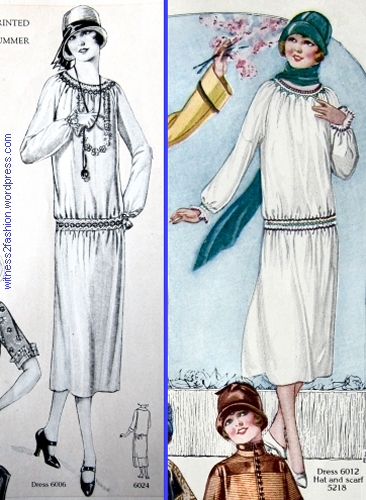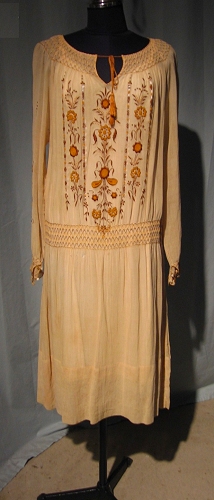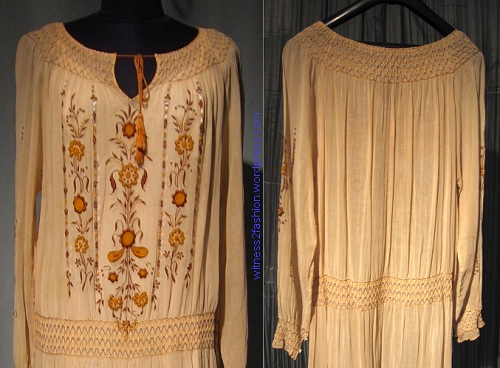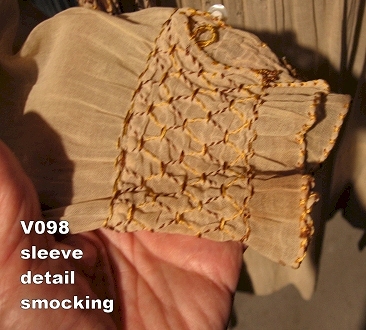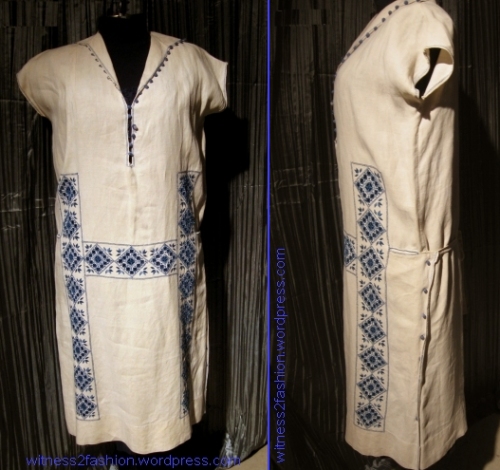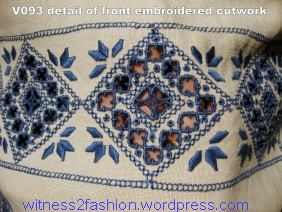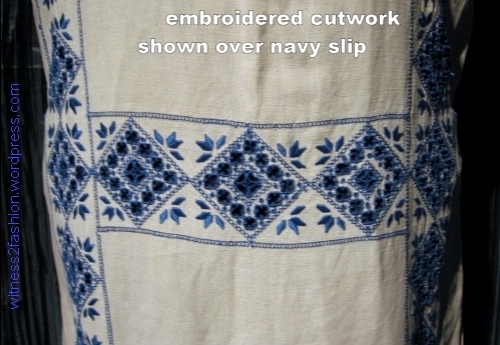While looking through some family photos, I found a few good examples of the persistence of fashion — a reminder of the variety that can be found within a historical period.
Fashion doesn’t change overnight — and it changes very slowly for some people. There is a theory called “the persistence of fashion” which accounts for the fact that clothing which is twenty or even thirty years out of date can be seen in many illustrations and photographs.

Story illustration, Woman’s Home Companion, Feb. 1936. The hem length of the woman on the right, about right for 1917 or 1923, demonstrates the persistence of an older fashion.
In the 20th century, the persistence of fashion was often associated with older women. (An older man wearing a suit that is twenty years out of date is barely noticeable, because men’s styles change very slowly — and some styles for men have changed very little since the nineteenth century.)
But, in the 20th century, it was older women who were usually depicted as clinging to the styles of their youth — or, at least, of their middle age.

“Jeanette Albers, Mrs. McLeod, and Nan McLeod,” late 1920’s.
Mrs. McLeod doesn’t look impoverished, but her dress is probably several years old. (Hems this long were last in style in 1923.) Jeanette Albers (left) has a hem which barely reaches her knees, suggesting 1927 or later. Nan McLeod (right) has a more conservative — or possibly two or three year old — outfit. It reminds me of this Chanel suit from January 1925 — which was not short.

Three generations. This picture was in an album, and dated 1921.
Although the youngest woman wears a mid-calf skirt appropriate for teenagers, her mother and grandmother wear much longer dresses — the plaid one could have been seen on a wagon train; she’s dressed like the 19th century prairie pioneers!
Wearing out-of-date styles is sometimes caused by a lack of money, or a body that cannot be made to conform to the current fashion ideal, or conservatism and/or prudery, or the expectations of the local community (the wife of a small-town businessman had to dress “respectably.”) Ageism is also a factor — an older woman who dressed to compete with marriageable younger women was called “mutton dressed as lamb.” [Note: a mutton chop, which comes from a fully grown sheep, does not taste like a lamb chop….]
I captured these two late fifties’ dresses from a clip of the Groucho Marx quiz show, You Bet Your Life. The older woman, a schoolteacher, is wearing a longish, conservative 1950’s dress, probably new, but not very different in style from what she would have worn in the 1930’s. The other woman is a teenager in flat shoes (“flats”) and a full-skirted knee-length dress.

Teacher and teen-aged girl on You Bet Your Life, probably 1960. The older woman has a longer skirt, sensible high heels, and 3/4 sleeves that cover her arms. This episode is copyright 1961, the show’s last season.

Female contestants on You Bet Your Life, a TV quiz show which ran from 1950 to 1960.
Mothers and grandmothers were not encouraged to present themselves as sexually attractive.

Persistence of Fashion in an advertisement for Sealy Mattresses, Delineator, Sept. 1917. The younger woman wears a V-neck blouse, a relatively new fashion in 1917, but the older woman wears a high, 1890’s style collar.
The reasons for the persistence of fashion among older women are many. Magazine illustrations and advertisements make it clear that among prosperous older women, many who could afford to keep up with changing styles chose to have their new clothing made with the high collars and low hemlines of a previous decade. Sewing patterns from 1918 allowed a choice of neckline.

Illustration of women in a restaurant, Delineator, Oct. 1924. The young women are very stylish, with bare arms and necks. Notice the persistence of an earlier fashion on the older woman in the foreground.

The waitress in the background, and the young women in the foreground, are dressed for 1924, but the older woman would not be out of place in 1910.
The older woman has the hairstyle and the high-waisted dress of the previous decade, although she is clearly a prosperous member of the middle class. She is comfortable wearing an older style that she feels is becoming to her.
The woman on the left in this photograph is dressed up and proud of it — in new-looking clothes that are ten years out of date.

Left: Mrs. Taylor and Helen Taylor in 1915. The young woman on the right is not wearing a shorter skirt because she is a child, but because it is the fashionable ankle-baring length.
Obviously, it is not lack of money that prevents this hostess from dressing in the current fashion:

This lady, with her butler at her side, could afford to dress in chic clothes, like the lady on the right — but she chooses not to. May, 1932, illustration by W. Morgan.
The older woman’s long skirt is a relic of 1923 — or even earlier. She is conservative in hair and hem.
I found this interesting example of the persistence of fashion in an article about women who volunteered to sew for soldiers during World War I:

One woman wears “full mourning”– circa 1898 — in a photo taken in 1917. Ladies’ Home Journal, November, p. 22. Poor woman — has she been in mourning for 19 years? [Edit: 9/10/16: Christina reminds me that this woman may be mourning a son lost in the early months of WW I; I failed to consider naval losses.]

Mourning costumes, 1898, from Victorian Fashions and Costumes from Harper’s Bazar.
The widow’s bonnet had a long black veil which could be pulled over the face for privacy, or to hide tear-swollen eyes. It’s a little surprising to see that Jacqueline Kennedy wore one at President Kennedy’s funeral — but it was over her normal pillbox hat.
Another extraordinary hold-over appears on the right in this photo:
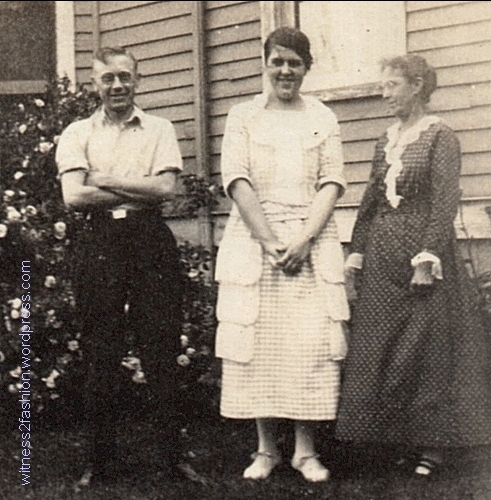
Persistence of fashion: Right, a turn of the century dress (or “wrapper”?) beside a dress from the late teens or early 1920s. The older woman has shortened her dress to walking length for housework — or to expose her shoes, which look new. Her throat is exposed, too, so this is a fairly new dress made in an older style, and worn over petticoats!
The Lack of Ready-to-Wear Clothing and the Persistence of Fashion
Today, we take the existence of “off-the-rack” ready-to-wear clothing in a range of sizes for granted. If we need a new coat, we go to a store and buy one, from a range of prices to fit most budgets.
That was not possible until the latter part of the 19th century. Suiting Everyone, published by the Smithsonian, was the book that made me aware of the importance of the U.S. Civil War (which ended in 1865) in developing the standardization of sizes. The urgent demand for hundreds of thousands of military uniforms, plus the development of industrial sewing machines, created a need for statistics about human measurements — and the war supplied them. For the first time it was possible to predict that a man with a 44 inch chest was statistically likely to have a 38 inch waist, and a man with a 38 inch chest was likely to have a 32 inch waist. Related back and sleeve lengths could also be calculated. [This is not to say that Civil War uniforms fit well!]
Elizabeth Ewing’s History of 20th Century Fashion makes it clear that standardized sizes for women happened later in England than in the U.S.; she says large-scale production of ready-to-wear in the early 20th century happened in America about ten years earlier than in Britain. (p. 122.) There, at the turn of the century, “The only dresses which were ready-made were those produced for window display.” (p. 40) At least one London department store would make up a dress, fully trimmed, and leave the back seam open, for easy “fitting” to the customer. [Note: this is the worst way to alter a dress!] Of course, the simplification of styles and the relaxed fit of women’s wear in the 1910’s and 1920’s made mass-produced clothing for women much easier to sell. A snug fit in the torso was not needed.

Unfitted styles like these, from Delineator, Sept. 1924, made ready-to-wear for women easier to manufacture and sell.
Before the 1860’s, most fitted clothing was custom made. If you could not afford to have your dresses and coats made for you, or make them yourself, second-hand clothing was all you could find. Sometimes, clothes had been passed through a long line of used clothing sellers and pawnbrokers. “The rag trade” was a literal description of the end of the line. The very poor wore rags. It was a “perk” of body servants in upper class houses to be given their masters’ and mistresses’ old and damaged clothing — sometimes after removing the re-usable trims and lace. The servants could not wear luxurious clothing themselves — at least, not where their employers could catch them in it — so it was sold. And sold, worn, pawned, sold, worn, and sold again. I recommend Diana de Marly’s book, Working Dress for an overview of what was and was not available ready-made before the late 1800’s. Ewing’s book discusses the earliest mass-produced items for women.
Clearly, the lack of ready-to-wear clothing at affordable prices used to have something to do with the persistence of fashion. However, there is a psychological element, as well.
As an older woman myself, I have lots of ten-year-old clothing in my closet. I haven’t reached the alarming proportions of my [Edited from “once beautiful” on 9/5/16] once fashionable great-grandmother, on the right, below:

Three generations, probably about 1910. The woman on the right has clearly lost all interest in current fashion — and in corsets.
… but I have always worn classic, straight-legged slacks. Sadly, I have them in sizes 12 through 16…. As I get closer to a healthy BMI, some barely-worn size twelves will return to the front of the closet. I’ll wear them, even if they were bought several years ago. [
Old Body, New Ideas
I’m retired. I don’t have to dress to impress anybody, because I no longer have a job telling other people how to dress. I no longer need to read WWD or fashion magazines, because I no longer design modern dress plays. I used to “shop” for a living (for clothing and fabrics,) so I don’t think of shopping as entertainment. Long ago, I met — and married — “Mr. Right,” so the fantasy of finding the perfect dress — “the one that will make me beautiful” — is over.
When I need something specific, like a new raincoat with a zip-out wool lining, I go to Nordstrom, just as I did when I was working. When I needed a dressy pair of water-and-snow-proof boots for a January vacation in New York City, I paid full price willingly — for the most expensive pair of shoes I have ever bought. (The vacation included reservations at a lot of good restaurants, plus an opera, plays, etc.) But in general I’m now much more likely to shop at Ross than at a major department store. When you prefer simple, classic styles in neutral colors, “last season” and “this season” aren’t very relevant. (And budget is a consideration — I am always saving up for a trip to Europe.)
Like the older women in these photos, I reject some new styles on sight. I’m not going to be buying any leggings or jeggings or any other tight-at-the ankle trousers, because I know from experience that, in them, I look really broad in the beam. I’ve been shopping for myself for 60 years; I know what to avoid by now. I already know what colors I should never wear (like yellow,) and which styles are most flattering to my narrow shoulders and wide hips. Plus, I am trying to get rid of “things,” not acquire them.
Buy Less, but Buy Better.
I admire people who try to limit their purchases of new clothing for ethical reasons. The excellent documentary The True Cost is a real eye-opener. In fact, it has me shopping for organic cottons — and it convinced me they are worth the price. Here’s a good idea: “Buy less, but buy better –” Better quality, and better for the world.
I realize I may end up as an example of the persistence of fashion, because I don’t own any up-to-the-minute fashions. But Fashion doesn’t own me.

It’s the 1930s. The woman on far right is even wearing trousers. Her mother, far left, wears a sunbonnet.














































